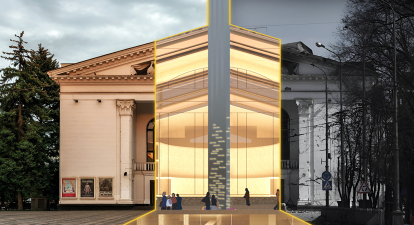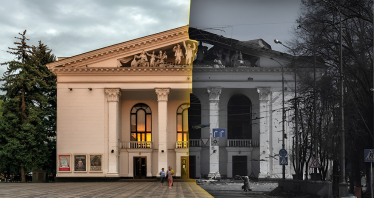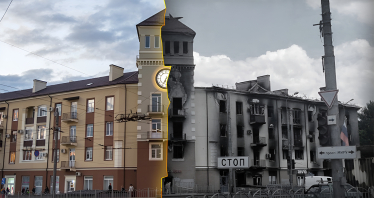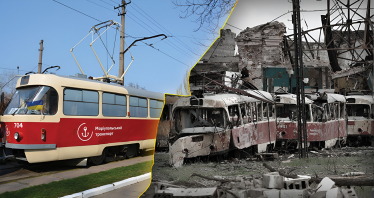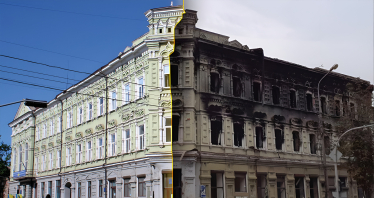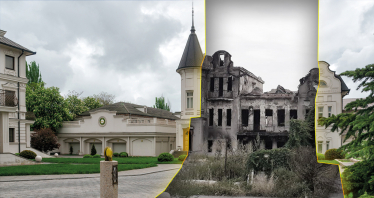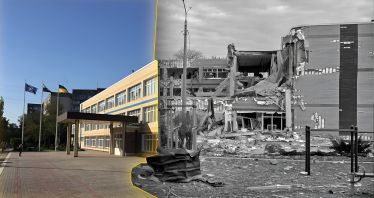Ukrainian towns and villages, once under Russian occupation, are steadily on the mend, thanks to the combined efforts of the government, foreign benefactors, and various international programs. This recovery is evident in regions such as Kyiv, Kharkiv, Zaporizhzhia, Mykolaiv, Chernihiv, and Kherson. However, numerous Ukrainian cities and villages remain under enemy control. To expedite and streamline the recovery process, it’s crucial to initiate large-scale reconstruction plans for Ukraine and develop corresponding projects, even before the war concludes. But how is this process currently unfolding?
A Historical Overview of Ukraine’s Regional Recovery
In 2014, the Russians inflicted damage to the infrastructure, environment, and housing stock of Donbas, amounting to $1 billion. Fast forward to 2023, and according to Ukrainian Prime Minister Denys Shmyhal, the cost has skyrocketed to over $700 billion. Data from the Cabinet of Ministers, the UN, the World Bank, and the European Commission indicate that post-war reconstruction will require $411 billion.
The government’s strategy to restore infrastructure in Ukraine’s eastern regions has been in place for nine years. In 2014, subsidies totaling UAH 375 million and UAH 300 million were allocated for the reconstruction of Luhansk and Donetsk regions’ infrastructure. That same year, Ukraine secured a €200 million loan from the European Investment Bank for the restoration of Donbas’s life support systems and infrastructure, and agreed with Germany on €500 million for regional infrastructure restoration. In 2017, the Ministry of Reintegration of Temporarily Occupied Territories and Internally Displaced People announced the execution of 80 reconstruction projects in Luhansk and Donetsk regions, with a budget of UAH 293 million. In 2018, the law on the reintegration of Donbas was enacted, and the governments of Canada and Sweden contributed $2 million, while the EU and the UN pledged €50 million for the region’s recovery.
Four years ago, with the World Bank’s support, Ukraine launched the International Partnership Support Fund for the reconstruction and future reintegration of Donbas. In 2020, the Cabinet of Ministers approved the Concept of Regional Economic Development. A year later, the Emerland Charitable Foundation was established to foster economic and social development in eastern Ukraine and rebuild communities. Amidst the full-scale war, the foundation began providing humanitarian aid and is planning the post-war reconstruction of Donetsk and Luhansk Oblasts.
Following February 24, 2022, the scope of areas requiring reconstruction has significantly expanded. In July of the previous year, the government formulated a Draft Ukraine Recovery Plan. The plan aims to quantify the specific damage inflicted on Ukraine during the war with Russia and devise a subsequent recovery strategy. Additionally, the State Agency for Restoration and Infrastructure Development of Ukraine has initiated 50 tenders for building reconstruction projects. Priority regions for recovery are those already de-occupied – Kyiv, Chernihiv, Sumy, Odesa, Mykolaiv, and Kherson regions. As of now, 18 contracts have been finalized.
Rebuilding Ukraine’s De-Occupied Regions in 2022
The temporary Russian occupation in 2022 resulted in substantial damage to the infrastructure in Donetsk, Kharkiv, Kherson, Mykolaiv, Zaporizhzhia, and Kyiv regions.
In 2022, Ukraine received a substantial aid of 1 trillion UAH from international partners, according to Prime Minister Denys Shmyhal. The following year, international benefactors allocated an additional $1.9 billion towards the recovery efforts.
Currently, the Kyiv region has seen the restoration of over 12.5 thousand structures affected by the occupation and hostilities. This includes 11.1 thousand homes, 187 educational institutions, over 100 medical facilities, and 68 administrative buildings. The region is also benefiting from the ʼNew Homeʼ and ʼReconstruction of Private Housesʼ programs, which provide assistance to those who lost their homes due to the Russian invasion.
In the spring of 2022, Irpin received UAH 65 million from the International Committee of the Red Cross. This funding was used to establish a water supply system for Kyiv and overhaul the sewerage network. Additionally, the Nordic Environment Finance Corporation contributed €7.7 million towards the repair of heat, water, and sewage facilities.
Bucha raised UAH 600 million from Ukrainian and international partners for reconstruction. The city also benefited from Austrian charitable foundations, which helped restore damaged educational institutions and buildings. Furthermore, Taiwan donated UAH 18 million to rebuild a school of martial arts.
In Irpin, 322 private homes have been restored at a cost of UAH 23.7 million. In the Gostomel community, 900 structures have been rebuilt, and in Borodyanka, the number exceeds 1700.
Restoration of critical and social infrastructure is underway in 220 de-occupied settlements of Kherson Oblast. Gas supply has been restored in 77 settlements, electricity in 188, and water supply in 175. Administrative Service Centers (ASCs) have resumed operations in 56 settlements. In October 2023, the State Agency for Reconstruction and Development announced the first two tenders for the construction of 13 residential buildings in the village of Posad-Pokrovske in Kherson Oblast. As of October 2023, 29% of critical and communal infrastructure has been restored in the Mykolaiv region.
The Chernihiv region is set to receive UAH 673 million from the Fund for the Liquidation of the Consequences of Russian Armed Aggression. These funds will be used to rebuild and repair schools, kindergartens, hospitals, and social facilities. In the Kharkiv region, recovery projects worth more than UAH 3 billion are underway. In the Zaporizhzhia region, 30 subprojects worth UAH 1 billion were implemented under the United Nations Development Programme and the Emergency Loan Program for the Reconstruction of Ukraine by the European Investment Bank.
The National Council for the Recovery of Ukraine estimates that the post-war restoration of the de-occupied territories of Ukraine will span at least a decade.
Projects to Restore Regions Still Under Temporary Occupation: The Mariupol Reborn Initiative
Mariupol, a Ukrainian city, has borne the brunt of Russian aggression, leading to a humanitarian catastrophe. The city’s losses amount to $14.5 billion. During nearly three months of blockade, Russians destroyed 929 high-rise buildings and 6,409 private houses, causing damage to 90% of the city’s infrastructure, including 12 hospitals and 63 schools. Approximately 290,000 city residents have become internally displaced.
The Mariupol Reborn platform team is contemplating the restoration of Mariupol post-de-occupation. The project, initiated by the Mariupol City Council with investment support from Rinat Akhmetov’s SCM and international benefactors, began in November 2022. This year, the first significant developments were showcased at the international conference, ReBuild Ukraine, in Warsaw.
Mariupol Reborn is an initiative that provides comprehensive and forward-thinking support for the city’s future reconstruction. An international team of architects and urbanists is already working on a spatial development plan, envisioning Mariupol post-de-occupation.
The next steps include projects for schools, residential districts, and municipal institutions. On November 2, the Mariupol City Council team unveiled the Fast Recovery Plan program on the Mariupol Reborn platform for swift urban recovery. This comprehensive plan aims for the rapid recovery of Mariupol post-de-occupation, focusing on the restoration of basic infrastructure, housing, administrative, and public services to create suitable living conditions for 150-250 thousand residents. The Fast Recovery Plan is slated for a two-year implementation period, involving nearly UAH 30 billion.
In November, the Mariupol Reborn project was showcased at the Kyiv International Economic Forum in Brussels. This initiative is designed to bolster international relations and seek funding. With a proven track record in urban reconstruction, EU countries’ expertise will be invaluable in rebuilding Mariupol. We have already forged cooperation agreements with the Union of Polish Metropolises, an association of 12 of Poland’s largest cities, including Warsaw, Gdańsk, Wrocław, and Jaworzno. Other cities involved in the agreement include Vilnius, Utrecht, Rotterdam, Brussels, Le Havre, and members of the International Association of Cities and Ports. Our partnership network also extends to international financial institutions and the USAID Economic Support for Ukraine Project.
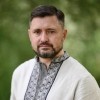
Vadym Boichenko
Mayor of Mariupol
«Mariupol is among the first cities in Ukraine to collaborate with international experts on a revitalization plan. Mariupol Reborn is one of the most extensive reconstruction projects since World War II. It’s a complex task, ranging from the Fast Recovery Plan, which will stabilize the situation immediately after liberation from the occupiers, to the construction of a new city. This endeavor requires support from the EU, G7, and major businesses».
Natalia Yemchenko, a member of the Supervisory Board of Mariupol Reborn and SCM’s Communications Director, emphasizes the urgency of the task. ʼWe need to start rebuilding Mariupol now, without waiting for the end of hostilities. After de-occupation, there will be no time to prepare: we will have to utilize whatever plans and resources we have. To rebuild better than before, we need to define what ‘better’ means by engaging citizens and holding discussions, a process that will take at least a year. Furthermore, reconstruction requires partners, investments, and grants — it’s not an easy task, so we need to start now. Additionally, the Russians must pay reparations for the destruction of Mariupol. The sooner we begin assessing damages and filing lawsuits in international courts, the closer we get to making the Russians pay for the losses,ʼ Yemchenko explains.
Preliminary estimates suggest that the restoration of Mariupol will take at least 20 years post-de-occupation and require $14.5 billion. The Mariupol Reborn project aims to transform Mariupol into a symbol of resurgence, not just for Donbas, but for all of Ukraine. Currently, Rinat Akhmetov’s SCM is financing nine Mariupol Reborn projects. The entrepreneur has allocated $1.5 million for the Fast Recovery Plan, Spatial Development Concept, concepts for rebuilding Ukrainian schools based on the ‘build back better’ principle, Mariupol Reborn Academy, and Chronicles of Mariupol Defense.
Natalia Yemchenko, a member of SCM and Metinvest, and personally for Rinat Akhmetov, emphasizes the importance of reviving Mariupol. ʼWe have strong economic and business ties to this city, and many of our employees are from Mariupol, making it our social responsibility. The state cannot shoulder the costs of rebuilding destroyed cities alone, so cooperation between business and government is crucial in the context of Ukraine’s post-war reconstruction. We aspire to set an example for all Ukrainian businesses.ʼ

Natalia Yemchenko
SCM’s Communications Director
«The vision for a rebuilt Mariupol is a European-style city, a stark contrast to its Soviet past. ʼThe Soviet system was totalitarian, with the city serving the work-home regime: dense buildings near factories, simplified lifeless public spaces. ʼWhile, the European city model we aspire to is a human-centered ecological city where everything is designed for the comfort of the citizens».
Vadym Boychenko, the mayor of Mariupol, notes that the Mariupol Reborn project has already prepared a Fast Track Recovery Plan and urban concepts for the city’s reconstruction. It has also launched Mariupol Reborn Platforms in Dnipro, Lviv, and Warsaw, where they are working on strategies for city reconstruction and attracting international funders and experts. Boychenko expects support from European countries, the international community, and large businesses in several areas. ʼThe first is the expertise that European countries have in rebuilding after World War II and in the economic transformation of cities. The second is modern experience: Mariupol wants to move away from Soviet approaches, so it is necessary to develop other ways of organizing educational, medical, social, infrastructure, housing, cultural, and barrier-free spaces. The third includes experts and companies that can assist with training, design, and implementation of projects. The fourth is support with equipment and materials immediately after de-occupation,ʼ Boychenko says.
Currently, the Mariupol municipality team is adopting the experience of the Dutch city of Rotterdam, which was destroyed in World War II, in terms of the optimal model of water supply and sewage. They will use the experience of the city of Le Havre to plan the development of port infrastructure, recreational areas, and tourism. In Gdańsk and Utrecht, Ukrainian experts are studying the experience of collecting, sorting, and recycling waste and creating a new city economy. Wrocław will help with its experience in developing an innovative technology park, IT cluster, universities, and building a road infrastructure management model. Brussels will provide expertise in creating high-quality medical infrastructure and services.
Вы нашли ошибку или неточность?
Оставьте отзыв для редакции. Мы учтем ваши замечания как можно скорее.

